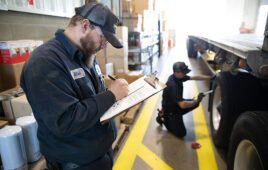 A solid foodservice P&L helps c-stores determine the true cost of food items, ensuring operators are pricing their offerings competitively.
A solid foodservice P&L helps c-stores determine the true cost of food items, ensuring operators are pricing their offerings competitively.
By CSD Staff
Although many people know a store profit and loss statement is important to understanding their business’s growth, it can be challenging to know what information to include when creating one. Often it can carry everything from the price of napkins to labor costs. Sarah Prorok, director of food and beverage at Thorntons Inc. in Louisville, Ky. explains how a P&L is a necessary tool in any c-store’s foodservice arsenal.
CSD: Why is a profit and loss statement important to a company’s foodservice operation?
Sarah Prorok (SP): Profit and loss statements are important for measuring sales units, dollars, average retails, gross profit and gross margin. Being in foodservice is a big commitment and being able to measure the results of that activity is important to understanding the return you are getting from that investment.
CSD: Should P&L statements be constructed for weekly, monthly or yearly assessment? Or should a retailer use all three?
SP: Monthly statements are important to understand how the changes you are making (promotions, products, pricing, etc.) are impacting the bottom line. Being able to monitor performance month to month and year over year allows you to identify trends to forecast and budget accordingly.
CSD: What are the more common expenses c-store operators should consider in terms of a P&L?
SP: Labor is a big part of the foodservice expense summary. Having a high amount of labor dedicated to fixed costs like routine cleaning and maintenance of equipment make the value proposition difficult if sales volume and profit are low. Basically the more you sell, the lower the fixed labor costs are as a percent of sales.
Retail cost of goods (products), non-retail cost of goods (associated supplies for retail products) and waste are also common P&L expenses. Waste is critically important but can easily be mismanaged. Retailers often make the assumption that no waste is a good thing. Having some waste indicates that we did not sell out and that we were in business during designated operating hours. On the flip side, excessive waste could indicate poor product quality, over-production and the wrong product variety, among other things. Having visibility on waste performance is important.
CSD: What are some related costs of a foodservice program that many c-store operators tend to overlook?
SP: At a high level, the cost of advertising and promotion can be daunting. This expense is not only an initial investment to gain and grow units but also a significant investment on an ongoing basis to keep guests aware and engaged with the foodservice program. The often difficult-to-measure benefits of advertising and promotion are organizational confidence, operational competence and ultimately, guest confidence in a foodservice program. In spite of these challenges, the returns from this expense should only compound over time.
CSD: How do you approach listing sources of income as it relates foodservice, beverage offerings, etc.?
SP: We monitor performance by subcategory for dispensed beverages including hot, cold, frozen, ice cream and the associated supply costs for each of those. Fresh food is similarly split into bakery, other fresh food (fruit, salads, snacks, etc.), roller grill, sandwiches and associated supplies.
CSD: What are some related costs that should be included in a P&L when assessing foodservice expenses?
SP: Outside of retail cost of goods or purchase costs, it is important to account for non-retail purchases such as condiments, cutlery, napkins, etc. If these expenses would not be occurring absent of foodservice sales, then they are a cost of being in the business and should be captured accordingly.
CSD: Do you have a tip for making the P&L process easier?
SP: Doing all accounting-related procedures consistently, accurately and timely makes the process and resulting outcomes more actionable and impactful. Having confidence in and understanding the numbers is the first step to reacting and implementing changes as a result.




